 |
|
 Why
go caving? Why
go caving?
 Caving
game Caving
game
 Caving
log file Caving
log file
 The
Caving page The
Caving page
|
 |
When going caving the main concerns that one should worry about
is the likely hood of getting cold, wet or overheated. Getting
lost is pretty bad as well and maybe the most important thing
would be finding the exit.
Caves can either be wet or dry but most of them have one thing
in common - they stay more or less the same temperature all year
round, and they are usually around 13-15 degrees. And yes, they
are usually dark.
Most people can go caving - it really does dependent entirely
on the chosen cave whether you would be fit for it or not. Obviously
some caves have to small passages for more heavily build people
to get through so here it is good to be slim and small. On the
other hand in wet (and therefore usually cold) caves it could
pay of having a bit of natural insulation although proper choice
of clothing should eliminate the need of layers of fat.
|
| |
|
|
|


|
|
Basic Requirements
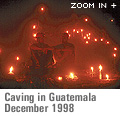 Let's
say you wanted to go into a Guatemalan cave - then your needs
would be fairly minimal. What you will need is a torch and a helmet.
The old Mayans supposedly did go caving without any pieces of
gear whatsoever (okay maybe except for a few pots and stuff) but
they never managed to get much further in than a couple of hundred
meters which is pretty impressive anyway, but they often couldn't
find the exit which wasn't so good. Here's
what happened to one of the poor guys. Let's
say you wanted to go into a Guatemalan cave - then your needs
would be fairly minimal. What you will need is a torch and a helmet.
The old Mayans supposedly did go caving without any pieces of
gear whatsoever (okay maybe except for a few pots and stuff) but
they never managed to get much further in than a couple of hundred
meters which is pretty impressive anyway, but they often couldn't
find the exit which wasn't so good. Here's
what happened to one of the poor guys.
So if you want to explore further than most people go and get
back again the two basic pieces of gear would be
- The Torch - essential for lighting up this total dark
environment - the most useful is the headtorch which can attach
to your head/helmet allowing your free arm movement which is
fairly critical in the more serious caving. There are two main
companies who do caving lights one is a company called Speleo
and the other one is Petzl. We both use Petzl's "Explorer"
system which has been really great so far. More on this later.
(Check out Mathias' custom build Light system nick named "The
Lighthouse")
- The Helmet - again - you could easily go caving without
a helmet but it would take you 2 nano seconds before you bang
your skull up in a big piece of rock and the fun would be over.
It's not like in climbing where the helmet can be somewhat of
a nuisance - in caving it quickly become your best friend. When
we went caving the first couple of times we just used our climbing
helmets and they work just fine - but as you get more into the
sport it's nice to get some proper stuff. So - again Petzl is
a major helmet manufacturer - and the Explorer system mentioned
in above is a complete helmet/light system which is superb.
Read further down for details.(I can't wait
- take me there now!)
These are the two basic pieces of kit and for many caves this
could probably be sufficient. But most of the time the caves present
you with factors that makes it necessary to add a few more items
to the list. Most of this comes down to clothing.
|
| |
|
|
|

|
|
Clothing
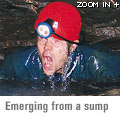 Inner
Layer. Let's assume your are going down into an wet English
cave. First thing you need is ideally a pair of swimming pants of
buffalo skids to take good care of your lower regions. Secondly
a layer of thin wool (Helly Hansen, Patagonia Polypro). Then you
need a thick layer of fleece - ideally a one piece fleecesuit. The
advantage of these materials is that they will keep you relatively
warm even though it is wet. If you are planning a trip which would
involve a lot of swimming and fully submersible activities then
forget the wool/fleece combination and put on an old wetsuit. I
have my thin old windsurfer longjohn suit which works really well.
Too thick and you'll have difficulty moving around, and it will
probably be too hot when you're not in water. Inner
Layer. Let's assume your are going down into an wet English
cave. First thing you need is ideally a pair of swimming pants of
buffalo skids to take good care of your lower regions. Secondly
a layer of thin wool (Helly Hansen, Patagonia Polypro). Then you
need a thick layer of fleece - ideally a one piece fleecesuit. The
advantage of these materials is that they will keep you relatively
warm even though it is wet. If you are planning a trip which would
involve a lot of swimming and fully submersible activities then
forget the wool/fleece combination and put on an old wetsuit. I
have my thin old windsurfer longjohn suit which works really well.
Too thick and you'll have difficulty moving around, and it will
probably be too hot when you're not in water.
Outer Shell. Your best option as your outer shell is the
Warmbag Oversuit. It is durable, waterproof and it is cut so you
have plenty of freedom of movement in the legs and arms. This
is usually the problem with a standard oversuit - it will restrict
your movements quite a bit. I have used a standard oversuit for
quite some time and it is a good cheap option, but it does make
a big difference wearing a Warmbag that fits you. A hood is nice
if you are planning to hang around in waterfalls a lot.
Footwear. The accepted standard for caving is wellington
boots ( gummistøvler). Mostly because of durability. Inside the
wellington you should fit yourself with some wetsocks - I forgot
mine once up in Yorkshire and instead I wore a thin pair of polypro
socks and a think pair of woolen. Mid way through the cave I started
getting seriously cold and the trip for me was then just a struggle
to keep going and wasn't as enjoyable as it could have been. You
loose a lot of heat from the feat and a pair of wet socks will
keep your little toes nice and warm.
gummistøvler). Mostly because of durability. Inside the
wellington you should fit yourself with some wetsocks - I forgot
mine once up in Yorkshire and instead I wore a thin pair of polypro
socks and a think pair of woolen. Mid way through the cave I started
getting seriously cold and the trip for me was then just a struggle
to keep going and wasn't as enjoyable as it could have been. You
loose a lot of heat from the feat and a pair of wet socks will
keep your little toes nice and warm.
Kneepads. Kneepads are nice. They tend to restrict your
walking a bit but if you are planning a lot of crawling, specially
on pebbles and small sharp rocks they are definitely recommendable.
Gloves. We have said it many times before and we will
say it again: "Vikings don't wear gloves". You see many
people wearing gloves - these are just soft deskjob workers who
care too much about there nails and manicures and too little about
the challenges and pleasures of the underworld.
|
| |
|
|
|
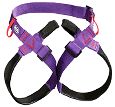
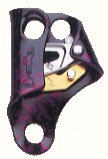
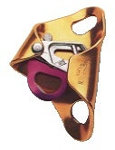
|
|
Additional Gear
Sometimes the cave can pose some obstacles that necessitates
a bit - or sometimes a lot - of extra gear. The most common of
problems is that of shafts deeper that one finds it safe to climb
(called a pitch). Encountering one or more of these vertical challenges
one should bring a ladder.
Ladder. The caving ladder is made of lightweight aluminum
which look similar to a ropeladder thus making it easy to roll
and pack for convenient transportation underground. They vary
in size and can be connected to eachother for really long pitches.
For caves where several pitches might be experienced and where
a small two person team want to travel ultralightweight, fast
and with optimum safety, the Single Rope Techniques (SRT) has
been developed.
 SRT
- Single Rope Technique. This is somewhat of a beautiful skill
that has been developed and perfected in fairly recent years.
For SRT'ing you need SRT
- Single Rope Technique. This is somewhat of a beautiful skill
that has been developed and perfected in fairly recent years.
For SRT'ing you need
- Harness - get a special caving harness, the tie-in
point is lower than on normal harnesses and the are more durable.
- Rope - although climbing ropes can be used static ropes
are the best. Preferably between 10.5 and 12 mm diameter. Length
depends on the cave.
- Descender - this is a gadget to will allow you to get
down the rope. The one I use is the Petzl "Stop".
(Pictured on the right)
- Ascender - this allows you to get up the rope again
and you need two. I use the Petzl hand ascender for the top
and the "Croll" for the body. (Pictured
on the left)
- Cowstails - these are just a piece of rope with a carabiner
in the end allowing you to clip yourself into bolts on re-belays
and deviation points.
- Various carabiners, maillons, spanners and bolts. I won't
go into details.
The whole universe of techniques and the tricks would be too
much to go into here but just buy the kit and find somebody who
knows what they are doing, become their friend and go SRT'ing.
It is excellent fun.
|
| |
|
|
| |
|
Where to go caving?
England is a pretty good place to start. France has
loads and loads of caves as well. So does Spain, Greece, Germany,
Eastern Europe, Ireland, America, Asia, Australia, New Zealand
and Africa. Basically you want a region of the world that has
limestone and stuff like that underneath you. Geology was never
my strong side so let's leave it at that.
Actually just about the only country which doesn't have
any cave potential whatsoever is probably our home country
Denmark. So whatever you do, try and avoid this otherwise nice
little country. 
Still curious? Check out this extensive
document on srt caving. 
|
| Foot note |
|
|
 |
|
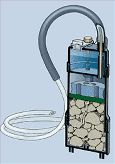 The
Petzl Explorer system The
Petzl Explorer system
Although rather tedious to keep in nice and clean condition
the Petzl Explorer system is pretty much the sexiest bit of caving
gear available on the shelf today. Just look at the photo on the
left - it oozes coolness right? It features an Aceto carbide lamp,
a Duo electrical torch, an Ecrin Roc Helmet, an Ariane plastic
(very lightweight) acetylene generator, and a watertight battery
pack on the back for the Duo headtorch on the front.
What I found trying carbide lighting for the first time was that
the ambient warm light that a flame gives you made the cave look
much more inviting and less claustrophobic that when using electrical
light thus making you more adventurous and less affected
by the scariness of the scary environment. The difference in experience
is really significant as I have tried to illustrate at the diagram
below.
 And
now you are ready to go caving. See you down there. And
now you are ready to go caving. See you down there.
|
|
 |